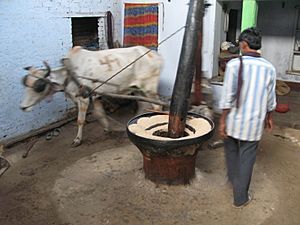Mustard oil facts for kids
Mustard oil is a special kind of oil that comes from mustard seeds. There are actually two main types of mustard oil. One is a cooking oil, which people use to prepare food. The other is a very strong-smelling oil called an essential oil.
The essential oil is made by grinding mustard seeds and mixing them with water. This creates a strong-smelling oil that can be collected through a process called distillation. This is like boiling a liquid and collecting the steam. The cooking oil is made by pressing the seeds, similar to how olive oil is made from olives.
Mustard cooking oil is very popular in countries like India and Bangladesh. However, in some other countries, like the United States, it's not allowed to be sold for cooking because it contains a lot of something called erucic acid. But don't worry, there are special types of mustard seeds that have very little erucic acid.
Contents
Mustard Oil for Cooking
About 30% of a mustard seed is oil! This oil can be made from different kinds of mustard seeds, like black mustard, brown mustard, and white mustard.
Mustard cooking oil has a unique, strong taste. This taste comes from a natural chemical called allyl isothiocyanate. You can find this same chemical in other spicy plants like cabbage, horseradish, and wasabi.
Mustard oil is mostly made of different kinds of fats. It has a lot of monounsaturated fats (about 60%), some polyunsaturated fats (about 21%), and a smaller amount of saturated fats (about 12%). These are all types of fats that our bodies need, but in different amounts.
Is Mustard Oil Safe?
Some types of mustard oil have high levels of erucic acid. Scientists have studied this acid to see if it can be harmful. Because of these studies, some countries, like the United States, do not allow mustard oil with high erucic acid to be sold for cooking. However, you can find special mustard oils that have very low amounts of erucic acid, and these are allowed.
What's Inside Mustard Oil?
According to the USDA, if you look at 100 grams of mustard oil, it has 884 calories. It is 100% fat. The fat in mustard oil is made up of about 11% saturated fat, 59% monounsaturated fat, and 21% polyunsaturated fat.
Mustard Essential Oil
The strong, spicy taste of mustard condiment happens when ground mustard seeds are mixed with water or other liquids. When this happens, a special reaction takes place between a natural substance called sinigrin (found in black or brown mustard seeds) and an enzyme called myrosinase. This reaction creates the chemical allyl isothiocyanate, which gives mustard its kick!
You can collect this very strong-tasting chemical by distillation to make an essential oil called "volatile oil of mustard." This oil is more than 92% allyl isothiocyanate. This chemical makes your mouth feel warm because it activates tiny sensors in your body called TRPA1 ion channels. White mustard seeds make a different, milder chemical, so their essential oil isn't as strong.
Allyl isothiocyanate is very important for the mustard plant. It helps the plant protect itself from animals that might want to eat it. It's like the plant's own natural defense system! The plant keeps this chemical stored in a harmless way until an animal starts to chew on it. Then, the strong chemical is released to scare the animal away.
This same allyl isothiocyanate is also what makes horseradish and wasabi taste so strong and spicy. Scientists can even make this chemical in a lab, and it's sometimes called "synthetic mustard oil."
See also
 In Spanish: Aceite de mostaza para niños
In Spanish: Aceite de mostaza para niños



